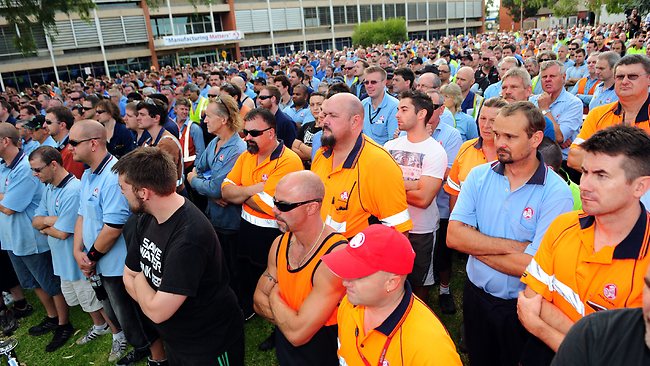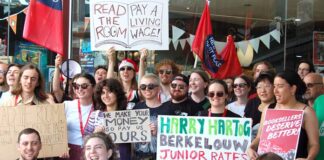After 64 years manufacturing cars in Australia, making billions in profit, and taking billions in government subsidies, General Motors Holden has announced its Australian factories will close in 2017. At least 3,000 directly employed workers face the sack and up to 45,000 jobs in the auto component manufacturing industry are at risk.
Shamefully, no one—not the Labor opposition, not The Greens and most shamefully, not the car workers’ union leaders in the Australian Manufacturing Workers’ Union (AMWU)—is proposing a fight for the Holden workers’ jobs.
But there could be a fight for jobs, nationally and internationally. If the union leaders gave a lead, there could be a campaign of industrial action to cut off Holden’s profits and exports, and appeals for community and international solidarity. Occupations could prevent Holden removing any valuable stock and equipment. Such a campaign would put immense pressure on Prime Minister Tony Abbott.
If Holden will not guarantee jobs, the campaign must call to nationalise the company. A campaign to turn its factories over to green manufacturing could mobilise both the union and the climate movements.
Make GM pay
The media has blamed workers and the unions for pricing Holden workers out of a job. Nothing could be further from the truth. General Motors’ Australian factories are, in fact, the most productive in the world. Yet workers have made concession after concession—only for the GM bosses to pocket the money and then cut jobs anyway. The Holden workers’ current enterprise agreement, signed in April 2013, locks in a wage freeze, while forcing every worker to work 16 minutes longer each shift for free.
Tony Abbott is offering only $100 million to South Australia and Victoria to retrain sacked Holden workers. It’s a joke. When Mitsubishi closed in 2008 only a third of the very highly-skilled car workers ever found full-time work again. Holden and Toyota workers will be thrown on the scrap heap without a fight to keep the jobs.
Successive governments have handed the car industry $30 billion since 1997—that’s almost $2 billion a year of public money. In 2008, at the height of the economic crisis, Holden workers agreed to work half-shifts and take a huge pay cut to keep operations going. Labor governments could have tied the granting of subsidies to job guarantees, but never did.
Holden made a combined profit in 2010 and 2011 of almost $202 million. But in March 2012 the Gillard Labor government gave another $215 million to Holden, claiming it would keep the company producing cars in Australia “for at least the next 10 years”. Within 13 months of this Holden had announced another 680 jobs would be cut.
In 2012, GM made a profit of $7.6 billion. They can afford to keep the factories open.
No more concessions
Right wing commentators are demanding that the lesson of Holden’s closure is that Toyota workers must sacrifice wages to keep Toyota manufacturing in Australia.
So far, the unions have resisted Toyota’s demands. But the risk is the officials will give in the same way they gave in at Holden. As the Financial Review revealed, “Many of the things Toyota wants—the shorter Christmas lockdown, fewer sickies, lower rates for new temps and freedom to use them—were agreed to by [the AMWU at] Holden. But the union doesn’t like how Toyota went about it.”
Nationalise Holden
Over the last 12 years Holden’s profits averaged $50 million per year. Australian taxpayers gave the company on average $153 million per year.
This means all the investments in plant and equipment and training has been bought by taxpayers and built by workers.
Australian workers have already paid for Holden’s Australian factories; they belong to the workers. If Holden won’t guarantee the jobs, we must fight to nationalise Holden—for a take over of its factories under workers’ control.
This would ensure that jobs and skills are maintained, and apprentices trained. Holden’s manufacturing capabilities could become a base for socially useful production to reduce carbon emissions—making large-scale solar plant equipment, public transport vehicles, wind turbines and so on.
Two bad arguments
But this is far from what we’ve heard so far.
The official political response to this calamity has been split between two poles—the free marketeers who argue that nothing can be done, and the protectionists who argue that the government could and should have acted to keep Holden here by offering new levels of government support on top of the $1.8 billion that the company has already received in the last decade.
While those who argue for ongoing subsidies are at least concerned to protect jobs, in reality subsidies only boost the car bosses’ profits and don’t guarantee jobs.
Abbott’s free market “do nothing” strategy shows his contempt for workers’ jobs. Indeed the Coalition government itself is sacking up to 14,500 public servants.
The protectionist argument of the Australian Manufacturing Workers’ Union (AMWU) and the Labor Party claims to be about saving jobs. Their protectionism, however, means subordinating wages, conditions and the right to a job to Holden’s profits.
Rather than organise the fight that’s needed, AMWU officials have even painted Holden as the good guys, arguing that Holden’s bosses have been fighting to keep operations in Australia.
It should be obvious that cosying up to the bosses hasn’t worked. It will take an industrial fight against both Holden and Abbott to save the car workers’ jobs.
Alternate plans?
The day before Holden announced its closure, Holden boss Mike Devereaux gave evidence to the Productivity Commission. He argued that for Holden to have to have a long term future in Australia, it needed a “Public Private Partnership” with government. Essentially, he wanted a government bailout, more stable and larger government subsidies to underwrite Holden’s “viability”, that is, profits.
This is the kind of bail out that GM got from Obama when the company filed for bankruptcy in the midst of the economic crisis in 2009. The US government forked out over $50 billion to save the company. But the Obama administration attached no strings to its effective takeover.
GM did make some repayments to the US government, but drove through savage cuts on a reduced workforce. Despite making a record profit over $7.6 billion in 2012, US taxpayers are still owed $10 billion that will never be repaid.
The South Australian Labor Premier, Jay Weatherill, has proposed other versions of government support for Holden. One suggestion is to turn Holden’s Adelaide plant into a government armaments factory as part of the $10 billion “Land 400” Defence project.
turn Holden’s Adelaide plant into a government armaments factory as part of the $10 billion “Land 400” Defence project.
The other proposal is to make the Holden factory part of the Port Adelaide defence shipbuilding Techport facility. In other words the Labor government can envisage the government taking over the plant (no doubt compensating Holden) if it is to be part of increasing Australia’s military capability.
The relationship between car production and the military has a long history. One of the key reasons governments subsidise car production is that there is a large overlap with the capacity to build military equipment, as was seen in the Second World War when governments demanded that car factories be immediately retooled to build jeeps, tanks and bombers. So far the government has made no guarantee that all the jobs would be guaranteed.
But rather than turning potentially useful manufacturing capacity over to the destructive aim of Australia’s military, the nationalisation of Holden needs to be the beginning of a green manufacturing sector—building green jobs for public transport, renewable energy infrastructure and community needs.
Jean Parker





